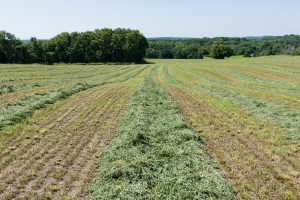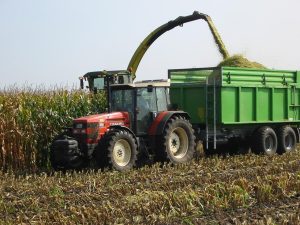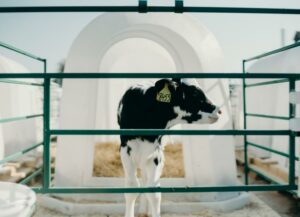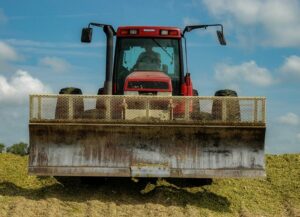Álvaro García
Effective preservation of alfalfa silage is critical to maintaining its nutritional value and ensuring optimal livestock performance. While harvesting and storing practices have evolved, heat damage remains a significant concern, leading to losses in both nutritional content and animal performance. Understanding the causes, mechanisms, and implications of heat damage, along with adopting modern management practices, can substantially mitigate these risks.
Causes of heat production in alfalfa silage
Heat damage primarily occurs when alfalfa silage is exposed to oxygen, allowing aerobic microorganisms to multiply. Although oxygen infiltration can occur at various stages—including during harvesting, silo filling, storage, or feed-out—each scenario has distinct implications. During harvesting, delayed wilting or prolonged exposure to sunlight and air can lead to increased respiration, causing sugars and nutrients to degrade. Once in storage, inadequate packing or incomplete sealing introduces oxygen pockets, creating hotspots where aerobic bacteria and fungi proliferate. Furthermore, during feed-out, slow removal or irregular cutting patterns allow oxygen to penetrate deeper into the silage mass, triggering microbial activity.
Research highlights that alfalfa silage with a higher dry matter (DM) content is particularly susceptible to heat damage due to reduced compaction efficiency and slower fermentation. Forages ensiled at DM contents exceeding 45% often experience greater heat damage and nutrient losses compared to those within optimal moisture ranges (35-40%).
Mechanisms behind heat damage
When oxygen infiltrates the silage mass, aerobic microorganisms utilize sugars and organic acids for respiration, releasing heat. This increased heat within the silage mass creates favorable conditions for the Maillard reaction (also known as non-enzymatic browning). The Maillard reaction occurs when reducing sugars, like glucose and fructose, chemically bond with the amino groups of amino acids, particularly lysine, forming indigestible complexes. This reaction is intensified under elevated temperatures caused by microbial respiration, especially in silages with higher dry matter content such as alfalfa. Consequently, proteins become less available to livestock, reducing the nutritional value and digestibility of the silage.
During the Maillard reaction, sugars and amino acids first combine to form intermediate compounds, which further undergo complex rearrangements to produce advanced glycation end-products. These end-products not only cause browning of the silage (giving it a dark, tobacco-like color) but also significantly decrease the nutritional availability of proteins and sugars.
The formation of heat-damaged proteins, measurable as Acid Detergent Insoluble Nitrogen (ADIN), reduces protein digestibility and overall nutritional quality of the silage. Consequently, animals consuming such silage experience reduced growth, milk production, and feed efficiency.
Research emphasizes that the Maillard reaction becomes notably active at temperatures above 40°C (104°F), with severe protein degradation occurring at temperatures over 60°C (140°F). The resulting brown coloration observed in heat-damaged silage indicates extensive binding between carbohydrates and proteins, significantly decreasing the availability of essential amino acids, thus negatively affecting animal performance.
Impacts of heat damage on silage quality
Heat damage can significantly impair silage nutritive value. A key indicator of this damage is the increase in acid detergent insoluble nitrogen (ADIN), a fraction that reflects protein bound to fiber and resistant to rumen microbial digestion. Elevated ADIN levels correlate strongly with decreased protein availability, reduced digestibility, and diminished livestock productivity.
Beyond protein, heat-damaged silages suffer losses of soluble carbohydrates essential for effective fermentation by lactic acid bacteria. Losses in these carbohydrates can lead to higher final silage pH values, negatively influencing silage stability and palatability.
Recent studies demonstrate that heat-damaged alfalfa silage can reduce voluntary feed intake due to poorer palatability. Furthermore, dairy cows fed heat-damaged silage exhibit decreased milk production, lower milk protein concentrations, and potentially impaired reproductive performance due to nutritional deficits.
The adjustment of protein content for heat damage in silage involves analyzing the Acid Detergent Insoluble Nitrogen (ADIN) content, also referred to as Acid Detergent Insoluble Crude Protein (ADICP). Here’s how to accurately interpret and apply this:
When silage is heat-damaged, the Maillard reaction causes proteins to bind with carbohydrates, creating compounds indigestible by the animal. These protein-carbohydrate complexes are measured as Acid Detergent Insoluble Nitrogen (ADIN). As ADIN increases, protein digestibility decreases. The digestible or available crude protein can be estimated by subtracting the ADIN fraction from total crude protein:
Available Protein (%) = Total crude protein (%) – (ADIN (%) x 6.25
- ADIN (%): Reported as percentage nitrogen insoluble in acid detergent fiber.
- 6.25: Conversion factor to express nitrogen content as crude protein.
Example:
If alfalfa silage contains:
- Total Crude Protein = 20%
- ADIN = 1.2%
Then:
Available protein = 20 – (1 x 6.25) = 20 – 6.25 = 13.75%
Thus, only 13.75% is considered digestible protein, while the remainder have been rendered unavailable by heat damage.
Heat damage also significantly reduces the energy availability in silage, primarily by forming indigestible complexes between carbohydrates and proteins. The reduction in energy is closely linked to the increase in Acid Detergent Insoluble Nitrogen (ADIN). As a result, the increase in ADIN is also a reliable predictor of energy loss in silages. The following approach can be used practically:
- Step 1: Identify the original ADIN (%) in normal alfalfa silage. Let’s say a well-preserved silage typically has an ADIN value of around 2%.
- Step 2: Measure your heat-damaged silage’s ADIN. If it comes back at 6%, that means there’s 4 percentage units increase compared to good-quality silage.
- Step 3: For each percentage unit increase in ADIN, energy digestibility (and thus the energy available to the animal) decreases. Typically, a simple rule of thumb is a 2–2.5% energy reduction per each percentage point increase in ADIN.
Calculations:
- Original forage ADIN: 2% and heat-damaged ADIN: 6% (an increase of 4 percentage units)
- Energy reduction assumption: Approximately 2% energy loss per 1-percentage-unit increase in ADIN (4 percentage units × 2% per unit = 8% total energy reduction)
- Original Energy: 1.30 Mcal/kg (NEL)
- New estimated Energy: 1.30 Mcal/kg × (100% – 8%) = 1.196 ≈ 1.20 Mcal/kg
Regularly testing alfalfa silage for ADIN is crucial for promptly identifying heat damage. Monitoring ADIN levels allows producers to accurately assess the nutritional status of silage, particularly regarding protein availability and energy content. Based on these results, rations can then be precisely adjusted to compensate for the nutritional deficits caused by heat damage. Additionally, supplemental high-energy feeds, such as grains or nutrient-rich by-products, may be incorporated into the ration to offset reductions in digestible energy and ensure animal productivity remains optimal. Collaborating closely with a nutritionist will ensure that these adjustments effectively support livestock performance, health, and farm profitability.
Management recommendations to minimize heat damage
Advancements in silage management strategies offer dairy producers’ practical tools to mitigate heat damage. Integrating these updated recommendations can substantially improve silage quality and enhance animal productivity.
- Harvest alfalfa at an ideal DM concentration of 35-40%, ensuring rapid wilting (ideally under 48 hours). Avoid excessively drying the crop, as higher DM contents decrease packing density and increase susceptibility to heat damage.
- Minimize field losses and aerobic spoilage by harvesting and filling the silo rapidly. Modern equipment, including precision-choppers and mergers, expedites this process, significantly reducing exposure to oxygen and sunlight.
- Improving compaction is critical to reduce oxygen infiltration. Recent innovations recommend targeting a packing density of at least 700 kg/m³ (approximately 44 lb/ft³) wet density. Achieving this density limits the initial oxygen content in the silo and reduces subsequent aerobic deterioration.
- Implementing advanced oxygen barrier plastics can reduce oxygen infiltration substantially compared to traditional polyethylene covers. Studies confirm that oxygen-impermeable covers markedly decrease spoilage and heat damage, preserving nutritional integrity.
- Silage inoculants—especially homofermentative strains such as Lactiplantibacillus plantarum—accelerate fermentation, rapidly dropping the pH below the critical 4.3 threshold, effectively inhibiting aerobic microorganism growth. Additionally, enhanced inoculants with enzymes such as cellulases, xylanases, and amylases can increase the availability of soluble carbohydrates, thus promoting more efficient fermentation and reducing the risk of heat damage.
- Continuous monitoring during storage using temperature probes and pH meters can alert producers early to signs of spoilage. Modern monitoring technologies, including remote sensing and data-logging equipment, facilitate early detection and intervention to prevent extensive nutrient losses.
- Adopt a systematic approach to feed-out, removing at least 25-30 centimeters daily from the silage face to minimize oxygen exposure. Maintaining a smooth, uniform face limits oxygen penetration and reduces the likelihood of spoilage. Automated silage removal systems and feed-out robots can significantly minimize oxygen exposure to the silage face.
- Routine silage testing for ADIN and ammonia nitrogen allows dairy producers to assess the extent of heat damage and adjust ration formulations accordingly. Adjustments, including supplemental protein or energy sources, can offset the negative nutritional impacts, maintaining animal performance and profitability.
Effective silage management offers dairy producers’ solutions to mitigate heat damage in alfalfa silage. Recognizing that high-quality alfalfa silage supports efficient livestock production, adopting updated management practices—such as rapid silo filling, superior compaction, use of modern oxygen barrier covers, inoculant applications, and careful feed-out management—will significantly enhance the economic returns of dairy operations.
By continually updating silage management practices based on current research and industry innovations, dairy producers can effectively protect the nutritional value of alfalfa silage and optimize animal health, productivity, and overall farm profitability.
The full list of references used in this article is available upon request.
© 2025 Dellait Knowledge Center. All Rights Reserved.








